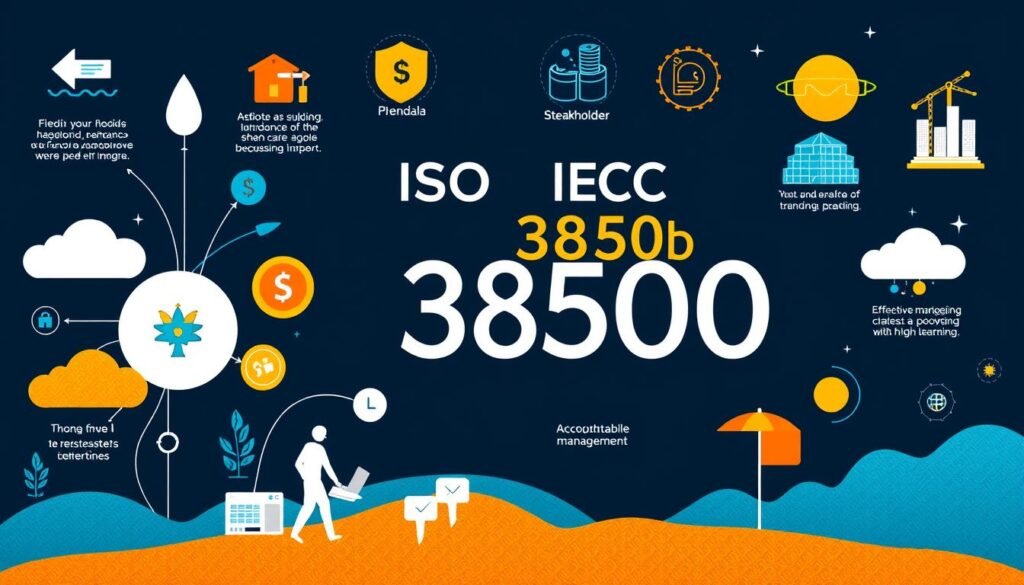In today’s digital-first business environment, effective technology governance has become crucial for organizational success. As we navigate the complexities of managing IT resources, it’s essential to align IT investments with business objectives to ensure maximum value creation.
We recognize that a proper governance structure enables organizations to utilize technology efficiently, safely, and in compliance with regulations, ultimately driving business value. As we explore the strategies for effective management, we’ll examine how technology governance has evolved into a strategic business function that drives competitive advantage.
Key Takeaways
- Effective technology governance is crucial for aligning IT investments with business objectives.
- A proper governance structure enables organizations to utilize technology efficiently and safely.
- Technology governance has evolved into a strategic business function that drives competitive advantage.
- Organizations must manage their technology resources effectively to drive business value.
- Compliance with regulations is essential for maintaining a robust governance structure.
Understanding Technology Governance in Modern Organizations
As organizations increasingly rely on technology to drive their business strategies, understanding technology governance has become crucial for success. In the modern business landscape, technology plays a vital role in shaping organizational operations, making effective governance essential for maximizing IT investments and achieving strategic objectives.
Defining Technology Governance and Its Importance
Technology governance refers to the structured approach to managing and controlling technology decisions within an organization. It is a framework that ensures IT management is aligned with the organization’s strategic priorities and goals, emphasizing IT accountability and value creation. Effective technology governance is critical because it enables organizations to make informed decisions about technology investments, manage risks, and optimize resources.
Technology governance differs from but complements corporate governance, focusing specifically on technology-related decision-making processes. While corporate governance encompasses the overall management and control of an organization, technology governance provides a specialized framework for managing IT resources and ensuring they align with business objectives.
The Evolution of Technology Governance
The formal history of IT governance began in 1993 as a subset of corporate governance. Since then, technology governance has evolved significantly, driven by the need for organizations to adapt to rapidly changing technology landscapes. The AS8015 Corporate Governance of ICT and ISO/IEC 38500 international standards have played a crucial role in shaping modern technology governance practices.
Initially, technology governance was primarily focused on compliance. However, it has transformed into a strategic business enabler that drives organizational value. Modern organizations are now adapting their governance approaches to address increasingly complex technology landscapes, leveraging technology to gain competitive advantages and improve business outcomes.
By understanding the evolution and importance of technology governance, organizations can better position themselves to navigate the challenges of the digital age and maximize the benefits of their technology investments.
The Business Value of Effective Technology Governance
By adopting effective technology governance, businesses can unlock the full potential of their technology investments and gain a competitive edge. Effective technology governance creates tangible business value by ensuring that technology investments support strategic objectives.
Aligning IT activities with business goals becomes much easier with the right governance strategy. This alignment enables organizations to realize the value brought to the organization by their IT investments. An effective governance structure allows businesses to draw out the most potential from their IT capabilities, removing bottlenecks and putting them ahead of their competitors.

Aligning IT with Business Goals
IT governance forces IT management to be aligned with business goals, driving the best positive results that matter to the organization. This alignment is critical for maximizing the value gained from IT investments. By ensuring that IT activities support business objectives, organizations can increase the overall value of their technology investments.
Competitive Advantages of Strong Governance
Organizations with strong governance frameworks gain competitive advantages through optimized technology utilization and resource allocation. Effective governance enables businesses to respond quickly to changing market conditions, innovate, and stay ahead of competitors. A well-structured governance framework facilitates better decision-making, allowing organizations to allocate resources more efficiently.
Risk Mitigation and Compliance Benefits
Effective technology governance also provides significant risk mitigation benefits, including improved security posture, reduced operational disruptions, and enhanced regulatory compliance. By implementing robust governance practices, organizations can minimize the risk of technology-related failures and ensure compliance with relevant regulations.
| Benefits of Technology Governance | Description |
|---|---|
| Aligning IT with Business Goals | Ensures IT activities support business objectives, maximizing value from IT investments. |
| Competitive Advantage | Optimizes technology utilization and resource allocation, driving innovation and competitiveness. |
| Risk Mitigation | Improves security posture, reduces operational disruptions, and enhances regulatory compliance. |
As noted by industry experts, “Effective governance is key to unlocking the full potential of technology investments.” By adopting a robust technology governance framework, organizations can drive business success and achieve their strategic objectives.
“The right technology governance strategy can significantly enhance an organization’s ability to achieve its business objectives.”
In conclusion, effective technology governance is essential for maximizing business value, driving competitive advantage, and mitigating risks. By aligning IT with business goals and implementing robust governance practices, organizations can achieve significant benefits and drive long-term success.
Key Components of Technology Governance
Understanding the key components of technology governance is vital for businesses to thrive in today’s digital landscape. Effective technology governance is not a one-time achievement but an ongoing process that requires continuous assessment and improvement.

Strategic Alignment and Decision-Making Processes
Strategic alignment mechanisms ensure that technology initiatives directly support business objectives and create measurable value. This involves establishing decision-making processes that enable timely, informed technology decisions while maintaining appropriate oversight and controls.
Accountability and Transparency Mechanisms
Clear accountability and transparency mechanisms are crucial for defining roles, responsibilities, and reporting structures within an organization. This helps to prevent confusion, overlapping work, or gaps in responsibility, ultimately leading to more effective governance.
Performance Measurement and Value Creation
Performance measurement frameworks are essential for tracking technology investments and quantifying their business impact. By using these frameworks, organizations can assess the value created by their technology initiatives and make data-driven decisions to optimize their governance approach.
By integrating these components, organizations can create a cohesive governance approach that balances control with innovation, ultimately driving business success.
Technology Governance Frameworks and Models
In today’s digital landscape, implementing a robust technology governance framework is essential for business success. Organizations are increasingly adopting various frameworks to enhance their IT management practices and align their technology strategies with business objectives.
COBIT Framework

The COBIT (Control Objectives for Information and Related Technologies) framework is a widely adopted IT governance framework that helps enterprises successfully implement governance strategies and navigate risk management. It provides a comprehensive set of control objectives and management guidelines to ensure effective IT governance.
ITIL Framework

The ITIL (IT Infrastructure Library) framework is one of the most popular frameworks that guide organizations in aligning their IT service management with business needs. It offers structured processes to enhance IT service delivery and support business objectives.
ISO/IEC Standards for Technology Governance

The ISO/IEC38500 standard is an international standard that provides guidelines for the corporate governance of IT. It helps organizations establish best practices for IT governance, ensuring that IT aligns with organizational objectives and delivers value to the business.
By understanding and leveraging these frameworks, organizations can create effective technology governance models that meet their specific needs. Whether it’s through COBIT, ITIL, or ISO/IEC standards, the key is to implement a framework that aligns with the organization’s goals and enhances its IT management practices.
The Role of Board Directors in Technology Governance
Board directors are now expected to play a pivotal role in shaping technology governance strategies within their organizations. As technology continues to advance at a rapid pace, the complexity of enterprise technology is increasing exponentially, making it challenging for board members to make informed governance decisions.
The corporate board has numerous stakeholders to be responsive to, including shareholders, employees, vendors, customers, and communities. Over time, technology has become a recurring topic of concern for boards. Research has identified four effective models through which boards engage with management on technology issues: regular full-board engagement, formal standing technology committees, temporary and/or advisory tech committees, and informal engagement on select topics.
Board Engagement Models for Technology Oversight
Boards can adopt various engagement models to oversee technology governance effectively. These include:
- Full-board engagement as a recurring agenda item
- Formal, standing technology committees
- Temporary and/or advisory tech committees
- Informal engagement on select topics
Each model has its advantages and can be chosen based on the organization’s specific technology needs and governance maturity. For instance, a full-board engagement model ensures that all directors are informed and involved in technology governance decisions.
| Engagement Model | Description | Advantages |
|---|---|---|
| Full-Board Engagement | Regular technology discussions at board meetings | Ensures all directors are informed and involved |
| Standing Technology Committee | Dedicated committee for technology oversight | Provides specialized focus on technology governance |
| Temporary/Advisory Committee | Ad-hoc committee for specific technology issues | Flexible and focused approach to technology governance |
| Informal Engagement | Ad-hoc discussions on select technology topics | Allows for flexibility and timely intervention |
Building Technology Expertise at the Board Level
As technology becomes increasingly critical to business operations, the need for technology expertise at the board level is growing. Boards can build this capability by:
- Appointing directors with technology backgrounds
- Providing technology training and education for existing board members
- Engaging external technology experts for advisory roles
Having the right technology expertise at the board level enables more informed decision-making and effective oversight of technology governance.
“The board’s role in technology governance is not just about oversight; it’s about enabling the organization to leverage technology for strategic advantage.”
Implementing Effective Technology Governance Strategies
Effective technology governance is not a one-time achievement but a continuous process that requires ongoing effort and commitment. Like other IT-related disciplines, IT governance is a continuous process that needs to be kept top of mind in an organization’s daily operations.
To implement effective technology governance strategies, organizations must start by developing a governance structure that clearly defines roles, responsibilities, and decision rights. This structure should be designed to facilitate collaboration between various stakeholders, including executives, IT teams, and other relevant parties.
Developing a Governance Structure
A well-designed governance structure is essential for effective technology governance. It should include clear definitions of roles and responsibilities, as well as decision-making processes that are transparent and accountable. To achieve this, organizations should leverage existing frameworks and best practices to inform their governance structure.
Creating Policies and Procedures
Once the governance structure is in place, organizations should focus on creating comprehensive governance policies and procedures that guide technology decision-making. These policies should be adaptable to changing business needs and technological advancements. It’s essential to prioritize employee education and training to ensure that staff understand and can implement these policies effectively.
Establishing Monitoring and Reporting Mechanisms
To ensure the effectiveness of technology governance, organizations must establish monitoring and reporting mechanisms that provide visibility into technology performance and compliance. This includes regularly reviewing IT performance, updating policies for remote or hybrid work environments, and continuously assessing the governance strategy to identify areas for improvement.
By following these steps and maintaining a commitment to ongoing improvement, organizations can implement effective technology governance strategies that drive business value and minimize risk.
Overcoming Common Challenges in Technology Governance
Effective technology governance is essential for organizations to harness the benefits of technology while mitigating associated risks. As we discussed in previous sections, technology governance plays a crucial role in aligning IT with business goals and managing risks. However, organizations often face several challenges when implementing and maintaining technology governance programs.
We identify and address the most common challenges organizations face when implementing and maintaining technology governance programs. These challenges include balancing innovation with risk management, managing the pace of technological change, and addressing cybersecurity and data privacy concerns.
Balancing Innovation with Risk Management
Organizations must strike a balance between encouraging innovation and managing risk. A robust governance framework can help achieve this balance by establishing clear policies and procedures for technology adoption and risk assessment. For instance, a governance model that includes a technology review committee can ensure that new technology initiatives are thoroughly evaluated for both their potential benefits and risks.
| Innovation Drivers | Risk Management Strategies |
|---|---|
| Encouraging experimentation | Implementing robust risk assessment processes |
| Fostering a culture of innovation | Establishing clear policies and procedures |
| Investing in emerging technologies | Continuously monitoring and reviewing technology initiatives |
Managing the Pace of Technological Change
The rapid pace of technological change presents another significant challenge for organizations. To manage this, organizations can adopt agile governance models that allow for flexibility and quick adaptation to changing technology landscapes. This can involve regular reviews of technology strategies and investments to ensure they remain aligned with business objectives.
Addressing Cybersecurity and Data Privacy Concerns
Cybersecurity and data privacy are critical concerns that organizations must address through their technology governance frameworks. This involves implementing robust security measures, conducting regular risk assessments, and ensuring compliance with relevant regulations. By prioritizing cybersecurity and data privacy, organizations can protect their assets and maintain stakeholder trust.
In conclusion, overcoming common challenges in technology governance requires a multifaceted approach that addresses innovation, risk management, technological change, and cybersecurity. By implementing effective governance strategies, organizations can navigate these challenges and achieve their business objectives.
Conclusion: Building a Future-Ready Technology Governance Strategy
As we navigate the complexities of technology governance, it’s clear that a well-designed strategy is crucial for organizational success. Boards can create value by understanding the connections between technology and their business, determining a clear vision and goals for their technology transformation, and anticipating and minimizing potential risks and threats.
Effective governance enables organizations to balance innovation with control and risk management. To achieve this, organizations must develop a governance strategy that is adaptable to evolving technological landscapes. This involves implementing best practices in governance and ensuring that the board is engaged in technology oversight.
By developing a comprehensive governance strategy, organizations can drive sustainable business performance and create lasting value. As technology continues to evolve, it’s essential for organizations to stay ahead of the curve and prepare for emerging trends and challenges. Ultimately, effective governance is not just about control, but about enabling organizations to thrive in a rapidly changing business environment.
